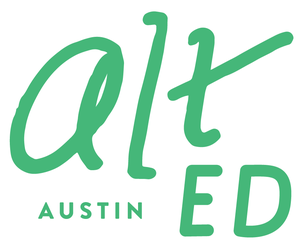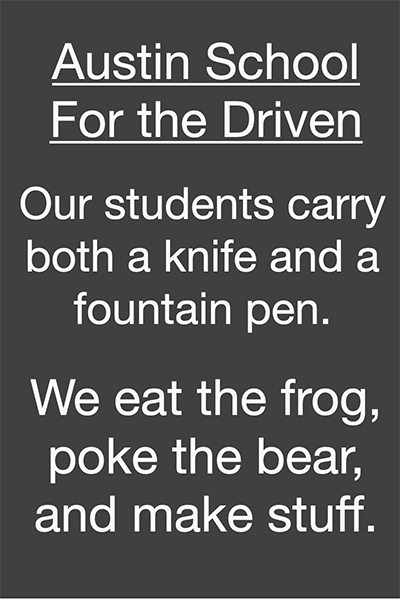The imagination is an essential tool
/We’re pleased to welcome Paige Arnell to the blog as a guest writer on the role of imagination and creativity in education today. Paige is the head of school at Kirby Hall School, which serves PreK through 8th grade learners in Central Austin.
The imagination is an essential tool of the mind, a fundamental way of thinking.
—Ursula K. LeGuin
The changing landscape of childhood is much discussed in the parenting and education world. The reality of digital saturation generates much debating of how, when, and where, and pundits of varying authority weigh in on benefits and dangers. Whatever your philosophy, there is no question that we’ve entered a radically new way of growing up.
There are many points of entry for the anxious here. No matter your pedagogy or teaching philosophy, for all educators it is a time of considerable questioning and revising.
One thing that is becoming more and more evident is that for earlier generations so much of the “work” of learning was happening outside of the schoolhouse door. When children were bored and left to their own devices—without devices, when children were gathering in groups together to make their own entertainment, when children were staring down the long hours of a blank afternoon, they were actively engaging in this essential work of imagining. Out of necessity, they made something out of nothing. They invented a landscape of discovery and collaboration. Obviously, some children did more than others; there were leaders and followers. This is not new information. Waxing nostalgic for childhoods of the past appears to be a perpetual exercise of adulthood; however, what we are newly considering is how much this work of recreation dramatically affected the tasks of the classroom. We now are seeing that children entering school without this practice are at a deficit, and that the tasks of deep learning are becoming more difficult for them.
Imagination is the foundation of critical thinking. Without imagination, we have no creativity, we have no curiosity. Without imagination, one might argue, we have no thinking.
This is nothing new, and resources abound for creative activities for children. Unfortunately, what many of these amount to are really no more than decorative activities. A creative writing prompt, a craft with a specific end product, a writing “journal” with pre-filled images and fill-in-the-blank responses. Perhaps some glue, glitter, and markers will be involved. These are nice activities, and many children enjoy them, and they make for cute wall decoration, but they rarely require real working of the mind.
These times require more from all educators. These times require us to ask ourselves more challenging questions. They require us to evaluate what it might mean to prioritize the imagination within our classrooms and schools.
If we truly take as a foundational principle the claim that “the imagination is an essential tool of the mind,” how might we need to reconsider the primacy of imaginative activity in learning environments, primarily in early childhood education? What does it mean to be free to imagine? Does it mean that we give ourselves permission to think of new things? Does it mean we give ourselves permission to try something really new—at least for us? Does it mean that we allow ourselves to act a different role, to move our bodies in a different way, to try a different voice, to try a new style of writing? Does it mean that we allow our mind to wander so freely that anything can happen … a puddle can become the ocean and twigs and leaves can become great ships? Does it mean that we allow ourselves to write familiar words in new combinations?
Yes, we might say, and we might say yes quite easily. In these times—in these times in which the mind is distracted almost continuously and so very rarely given the quiet and time it needs to drift into the world of imagination—in these times, educators must push themselves even further. We must push ourselves beyond a simple yes and into a deep consideration of the fundamental changes that a radical commitment to honoring the work of the imagination would look like beyond glittery decoration.
If we believe that the transformative and powerful work rests on a bedrock of imagination and creative thinking—that critical thinking and the production of ideas can only grow from this rich soil—then how do we need to change our classrooms? It seems we must give our students a few things:
We must give them time, specifically, unstructured time. If we fill their days with tasks and to-dos, they may never reach the space in which a stick becomes a wand or a telescope.
We must show them our own willingness to play and engage with the world in new ways. If we view children’s imaginative free time as time for us to check out of their world, we are showing them that imagination is secondary.
We must give primacy of place to their creations and to their work—no matter how messy it may be. Imagination vitally requires process and not production. Let’s take down the professionally made posters. Let’s allow our students to create the classroom.
We’re called now to create communities in which school provides an almost sacred place for play and exploration, for the joy in creating and making messes. Parents and educators have an incredible opportunity to support each other in this work that may not produce a worksheet one can tape to the fridge, but rather supports the growth of a mind in all of its wonder and full humanness.
—Paige Arnell, Head of School | Kirby Hall School













